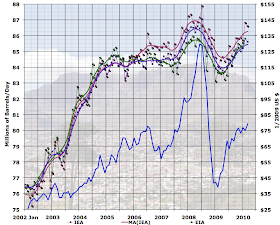With all the excitement last week over Paul Krugman's essay, and then the volcano, I'm rather late on updating my graphs of global oil production. I've been tracking the recovery in global production on a monthly basis. The first version of March's statistics show a slight reduction over February's numbers. However, the latter were revised slightly upward. Overall, the pattern has not changed; global oil production is recovering apace:
The rate of recovery I currently estimate at 2.9 mbd/year, with a 90% confidence interval of [1.8, 3.9] mbd (using the same approach as last month). It still appears to me that the most likely outcome is that this recovery will continue and exceed the 2008 peak of liquid fuel production - I suppose the largest near-term risk to that would have to be on the demand side: a renewed financial crisis due to a Greek default.


Greece is important out of proportion to its tiny size. But there is not enough outstanding debt, in my view, to shake things up in the face of so much state support around the world. Not that something big enough won't pop up.
ReplyDeleteBut on that note, I'll be suspending my 5-year long professional hobby (almost) of trying to understand our energy situation and civilization in general. Time to move on to other things.
Civilization-watching is an addictive pastime!! -- much more so when there are smart folks like yourself who take take the trouble to share their thoughts and interact. Thanks, Stuart.
DM: Ah, you'll be greatly missed if so. Hopefully you'll drop back in once in a while. And if not, fare thee well, and thanks for all the great comments.
ReplyDeleteStuart,
ReplyDeleteAs a first-time poster but long-time reader, I want to thank you for all your great work. I have been fascinated by the role of NGLs in current production growth. I point out on my blog (http://peakoilquestionoftheday.blogspot.com/2010/04/more-on-ngls.html) that all of the current production growth appears to be coming from NGLs and not crude. Furthermore, on a BTU basis, "energy" production is flat even though the world is producing more "barrels".
What I'm struggling with is what this means. My understanding is that NGLs are not easily convertible to liquid transportation fuels. So we may see the counter-intuitive result of higher "oil" production along with higher gas and diesel prices. Your thoughts?
Thanks,
Stephen O'Brien
Stephen:
ReplyDeleteThanks for kind words!
It's certainly true that NGLs are increasing, but it's also the case that even the crude-only supply was higher in 2008 than 2005-2007 - as your second graph shows - and the crude supply is increasing now. Since OPEC spare capacity is largely in the form of crude, I expect (assuming that OPEC is willing to deploy their spare capacity at prices not too much higher than now) that the crude line will also exceed it's 2008 peak.
So while the quantitative details are a bit different if you look strictly at crude, I think the qualitative picture is similar. None of these aggregates are perfect as measures of "oil" but I prefer to be inclusive rather than pick the components that will tend to present the most pessimistic picture.
Stuart,
ReplyDeleteYour point is fairly made and reasonable. If I may, however, it seems that just a focusing on oil could be called the pessimistic view, it is equally valid to say that total liquids is the optimistic view. However, it is a minor point and I, too, am interested to see if total liquids hits a new high. If Colin Campbell is to be believed, 2010 will be the peak for total liquids. Time will tell.